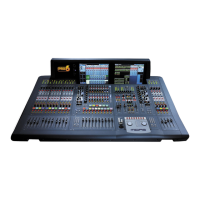Glossary 581
PRO6 Live Audio System
Owner’s Manual
Envelope: 1. How a sound or audio signal
varies in intensity over time. 2. The visual
representation of such, usually shown on a
graph in a GUI channel strip.
EQ: Abbreviation for “equaliser” or
“equalisation”.
Equalisation: Adjusting the frequency response
so that the levels of all frequencies are equal or
the same. Bass and treble controls are
equalization controls.
EtherCon®: A cable connector for data transfer
interconnections, which is more robust than the
basic RJ45.
F
Fader: Slider-type device for precise
adjustment of signal level or volume of a
channel.
Fast strip: One of the strips in the input, mix
and output fast zones. See Input fast strip, Mix
fast strip, Output fast strip and Fast zone.
Fast zone: An area on a bay that contains quick
controls. See Input fast zone, Mix fast zone,
Output fast zone and Fast strip.
FB: Abbreviation for “front-back”. A term used
in surround panning.
Feedback: See Acoustic feedback.
Filter: A device for removing frequencies above
or below certain levels.
FOH: Abbreviation for “front of house”. The
area in a theatre used by the public. Used to
describe a control centre being used to control
the sound that the audience will hear (and not
the performers’ monitor system).
Frequency: The number of times that a sound
wave’s cycle repeats within one second.
Fricative: A consonant, such as “f” or “s”,
produced by the forcing of breath through a
constricted passage.
From section: The leftmost area of the
patching screen that contains the source patch
connectors. See Patching.
G
Gain: Another term for signal level.
Gain reduction (compressor): Decrease in
gain when input signal is above threshold. See
Gain.
GEQ: Abbreviation for “graphic equaliser”. See
Graphic EQ.
GEQ rack: A virtual rack of GEQs. See Virtual
rack.
Granularity: A measure of the size of
components or a description of the components
comprising a system.
Graphic EQ: A form of EQ that has a number of
faders for controlling the gain of the audio
signal. The faders are set at frequency bands
that are evenly-spaced according to octaves.
GUI: Abbreviation for “graphical user interface”.
GUI channel strip: Right section of a GUI
screen that represents the processing area of
the input or output channel strip selected to the
control surface.
GUI menu: A menu selectable at either GUI
screen by clicking the home button (upper-left
corner).
GUI screen: One of the PRO6’s two screens,
which comprise the GUI.
H
HPF: Abbreviation for “high pass filter”. A filter
that removes lower frequencies from a signal,
leaving the higher frequencies unaffected.
Hum: Undesirable low frequency tone present in
a signal due to grounding problems or proximity
to a power source.
Hz: Symbol for “Hertz”. A unit of frequency
equal to one cycle of a sound wave per second.
I
I zone: Area on the master bay that contains
the operator-assignable effects controls.
I/O: Abbreviation for “input/output”.
ID: Abbreviation for “identification”.
Ident: Scale marking, or gradation, around a
control knob to help indicate the current setting
and to assist in accurate adjustment.
Impedance (Z): Opposition to the flow of
alternating current in a circuit, measured in
ohms.
K
Kernel: For computers, the kernel is the central
component of most operating systems.

